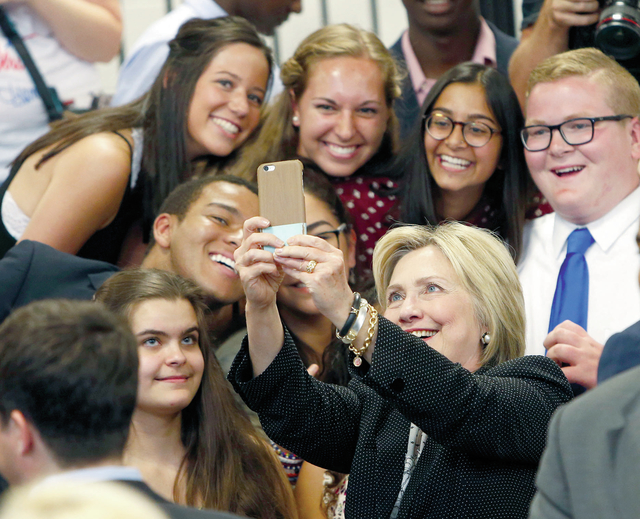WASHINGTON — Liane Golightly has finally decided who she’ll vote for on Election Day. Hillary Clinton is not a choice the 30-year-old Republican would have predicted, nor one that excites her. But the former supporter of Ohio Gov. John Kasich
WASHINGTON — Liane Golightly has finally decided who she’ll vote for on Election Day. Hillary Clinton is not a choice the 30-year-old Republican would have predicted, nor one that excites her. But the former supporter of Ohio Gov. John Kasich says it’s the only choice she can make.
“I kind of wish it were somebody else, somebody that I could really get behind 100 percent,” said Golightly, an educator from Monroe, Michigan. She’s voting for Clinton, she said, only because she can’t stomach “childish” Donald Trump.
Like Golightly, many young voters are coming over to Clinton in the closing stretch of the 2016 campaign, according to a new GenForward poll of Americans 18 to 30.
Driving the shift are white voters, who were divided between the two candidates just a month ago and were more likely to support GOP nominee Mitt Romney than President Barack Obama in 2012.
In the new GenForward survey, Clinton leads among all young whites 35 percent to 22 percent, and by a 2-to-1 margin among those who are likely to vote. Clinton held a consistent advantage among young African-Americans, Asian-Americans and Hispanics in earlier GenForward polls, as she does in the new survey.
The new poll also suggests enthusiasm for voting has recently increased among young African-Americans, 49 percent of whom say they will definitely vote in November after only 39 percent said so in September. Just over half of young whites, and about 4 in 10 Hispanics and Asian-Americans, say they will definitely vote.
GenForward is a survey of adults age 18 to 30 by the Black Youth Project at the University of Chicago with the Associated Press-NORC Center for Public Affairs Research. The first-of-its-kind poll pays special attention to the voices of young adults of color, highlighting how race and ethnicity shape the opinions of a new generation.
Overall, Clinton leads Trump among young likely voters 60 percent to 19 percent, with 12 percent supporting Libertarian nominee Gary Johnson and 6 percent behind the Green Party’s Jill Stein. If Clinton and Trump receive that level of support on Election Day, Clinton would match Obama’s level of 2012 while Trump would fall short of Romney’s.
It’s not necessarily because they like Clinton, but is nevertheless a late sign of strength among a voting bloc that the former secretary of state has struggled to win over.
“There’s a gray area with her, where maybe she hasn’t broken any laws, but she’s always skirting the edge, it seems,” said Galen Mosher, 30, a lighting technician from Sandy, Oregon, who voted for Clinton’s primary rival, Vermont Sen. Bernie Sanders.
Mosher, who is white, said he got behind Clinton once she won the Democratic nomination, because “at least she’s a step” toward the free college tuition and higher taxes for wealthy people that Sanders had proposed.
The poll also provides evidence that Trump’s behavior toward women has hurt him among young voters, while Clinton’s characterization of a large portion of the New York billionaire’s supporters as “deplorable” did not damage her candidacy.
The GenForward survey included interviews both before and after the release of a 2005 recording on which Trump brags about sexually assaulting women. But support for Trump didn’t shift among young voters overall or among young whites after the tape was released, suggesting the shift in young whites to Clinton came first.
All of the poll interviews, however, were conducted after the first presidential debate, when Clinton told the story of former Miss Universe Alicia Machado and Trump’s assessment of her as a “Miss Piggy” after she gained weight. Most young people across racial and ethnic lines say that Clinton’s accusations in that debate about Trump’s behavior made them less likely to support the GOP nominee.
Most young people weren’t turned off by Clinton calling some Trump supporters “deplorable” in September. Sixty-two percent of young adults, including 82 percent of African-Americans, three-quarters of Latinos and Asian-Americans and 51 percent of whites said they agree with her assessment.
The poll also found that 45 percent of young adults have a favorable view of Clinton, while just 17 percent say the same of Trump. Conversely, half have an unfavorable view of Clinton and 77 percent have that view of Trump.
Young whites say they have a more favorable view of Clinton now than going into the fall. Among that group, three-quarters have an unfavorable view of Trump now, up from 67 percent in September.
The survey also showed young whites are slightly less likely to see Trump as qualified to be president, down from 30 percent in September to 24 percent.



